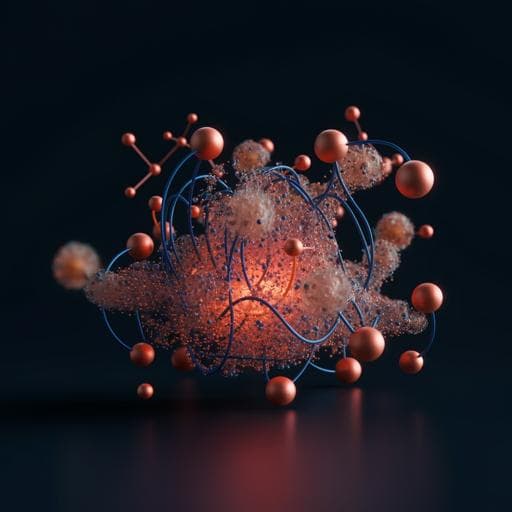
Chemistry
Single-atom alloy catalysts designed by first-principles calculations and artificial intelligence
Z. Han, D. Sarker, et al.
This groundbreaking research conducted by Zhong-Kang Han, Debalaya Sarker, Runhai Ouyang, Aliaksei Mazheika, Yi Gao, and Sergey V. Levchenko introduces a compressed-sensing data-analytics approach to discover new single-atom alloy catalysts (SAACs). Uncovering over 200 new candidates, this study is set to revolutionize catalyst design with superior alternatives to existing options.
~3 min • Beginner • English
Introduction
The study addresses the challenge of rapidly and reliably predicting catalytic performance and stability for single-atom alloy catalysts (SAACs), which are highly dilute bimetallic alloys where isolated noble-metal atoms are dispersed in an inert host. SAACs have shown exceptional activity and selectivity in hydrogenation-related reactions due to a balance between H2 dissociation efficiency and optimal H binding strength. Traditional descriptor-based approaches (e.g., Brønsted–Evans–Polanyi relationships, d-band center correlations, and adsorption-energy scaling relations) provide useful but approximate linear correlations that often break down for SAACs due to their unique local electronic structures. Moreover, catalyst stability (e.g., resistance to segregation or aggregation) has not received equal attention despite its importance. The purpose of this work is to combine first-principles density functional theory (DFT) with compressed-sensing symbolic regression to develop fast, accurate predictive models for key SAAC properties—hydrogen binding energy (BEH), H2 dissociation barrier (Eb), and guest-atom segregation energies (SE and SEH in the presence of H)—and to use these models for high-throughput screening and mechanism insight via data mining.
Literature Review
Prior experimental and theoretical works established SAACs as highly efficient and selective catalysts for hydrogenation and related reactions. Sykes and co-workers demonstrated isolated noble-metal atoms on coinage-metal hosts enhance reactivity and selectivity. Kyriakou et al. showed isolated Pd atoms on Cu surfaces reduce barriers for hydrogen uptake and desorption; single Pt atoms on Cu(111) selectively hydrogenate butadiene to butenes. A range of SAACs have been synthesized and studied, including Pd/Ag, Pt/Cu, Pd/Au, Pt/Au, Ru/Au, and Ni/Cu, with activity/selectivity toward diverse hydrogenation reactions. Descriptor-based catalysis models, including BEP relations and d-band theory, and adsorption-energy scaling relations have guided catalyst design but can fail for SAACs due to nonlinearity and local effects. Stability considerations such as segregation energies have been less systematically integrated into SAAC screening, motivating approaches that jointly capture activity and stability.
Methodology
The authors combine DFT calculations with compressed-sensing symbolic regression using SISSO (sure independence screening and sparsifying operator) to derive low-dimensional analytic descriptors for BEH (H binding energy), Eb (H2 dissociation barrier), and SE (guest-atom segregation energy), and to compute SEH (segregation energy in presence of adsorbed H) from SE and BEH. Dataset: Over 300 SAAC systems were computed with DFT (RPBE exchange-correlation within FHI-aims; revised PBE-vdW-DF functional), covering diverse transition-metal hosts (e.g., Zn, Cr, Co, Ni, Pt, Pd, Rh, Ru, Ag, Ti, Nb) and low-index surfaces, with single guest atoms substituting a surface atom. Adsorption sites and BEH were evaluated and validated against literature. Primary features for SISSO include atomic-level and surface-level properties of host and guest: highest-occupied and lowest-unoccupied Kohn–Sham levels, electron affinity, ionization potential, cohesive energy, d-band centers (bulk and surface), slab Fermi level, H binding energy and distance to isolated atoms, and geometric/bonding proxies; host-derived features are obtained from pristine surfaces for computational efficiency. SISSO generates a large pool of candidate functional forms using simple operators (+, −, *, /, absolute value) and identifies sparse descriptors correlating with the target properties. Model validation: 10-fold cross-validation (CV10) is used to prevent overfitting and determine optimal descriptor dimensionality; root-mean-square errors (RMSE) and maximum absolute errors are reported. High-throughput screening: Using the SISSO models, >5000 SAAC candidates (flat and stepped surfaces) are screened. Selection criteria combine activity-related metrics (weak H binding and low H2 dissociation barrier) and stability (segregation energies SE and SEH), with temperature- and pressure-dependent thresholds (e.g., 200 K and 700 K at 1 atm). Activity-stability mapping uses a composite activity metric involving ΔGH and Ea. Subgroup discovery (SGD) is applied to the SISSO-evaluated dataset (~5200 surfaces) to identify interpretable selectors (inequality-based conditions on features) that minimize target properties (e.g., SE, SEH, ΔGH) and reveal mechanistic trends. Computational details: FHI-aims all-electron code; validation against experimental H2 adsorption energies; BEH and SEH computed via specified energy expressions from DFT components, with SEH derived from SE and BEH models.
Key Findings
- SISSO produced accurate analytic models for BEH, Eb, and SE with low RMSE and robust CV10 performance, enabling predictions orders of magnitude faster than direct DFT (at least 1000× speedup).
- d-band centers and cohesive energies consistently appear in the optimal descriptors, confirming their central role in adsorption and segregation trends; descriptors rely on simple operators yet capture complex non-linearities where simple linear d-band relations fail for SAACs.
- High-throughput screening (>5000 candidates) identified: 160 flat-surface and 134 stepped-surface SAACs that are both active and stable at 200 K; 102 flat-surface SAACs remain promising at 700 K. Over 200 previously unreported promising SAACs were found.
- Incorporating stability via SE (and SEH) changes predictions: candidates like Pd/Ag and Pd/Au, while active, have low stability experimentally; the models capture H-induced segregation trends (e.g., SE for Pd/Ag(110) ≈ 0.3 eV and Pd/Ag(111) ≈ 0.46 eV), consistent with observed behavior under H2.
- Activity–stability trade-off observed: negative correlation between activity metric and stability; nonetheless, several materials lie near the optimal lower-left region of the activity–stability map and outperform reported SAACs.
- Highlighted promising systems include M/Ag(111) and Ru/Zn(001) among others, balancing stability, activity, abundance, and safety (aggregation energies reported in Supplementary data).
- SGD analysis yields interpretable mechanisms: low SE correlates with host cohesive energy magnitude exceeding guest cohesive energy and with high guest ionization potential, suggesting a preference for maximizing host–host bonding and reduced charge transfer that destabilizes surface guest positioning. Effects of H on stability are modest overall, but specific subgroups show SEH approaching or dropping below zero, revealing conditions where adsorbed H significantly alters segregation tendencies.
Discussion
The combined DFT–SISSO framework directly addresses the core challenge of rapidly predicting SAAC activity and stability across vast chemical spaces. By constructing descriptors solely from host and guest elemental and pristine-surface features, the models avoid costly alloy supercell calculations while retaining predictive accuracy, enabling high-throughput discovery. The findings validate and extend traditional catalysis concepts: while d-band and BEP heuristics offer guidance, SAAC reactivity and stability exhibit non-linear behavior not captured by simple linear relations; the SISSO models capture these complexities. Incorporating stability (SE, SEH) is essential; otherwise, some experimentally unstable but active systems would be overselected. The screening demonstrates a temperature-dependent window where different binding and barrier limits are optimal, and maps the inherent activity–stability trade-off, yet identifies exceptions where both are favorable. SGD provides mechanistic insight into stability drivers—cohesive energy contrasts and guest ionization potential—and clarifies when H adsorption meaningfully changes segregation tendencies, guiding rational selection of host–guest pairs. Overall, the approach reduces bias in candidate selection and yields practical leads with improved performance over known SAACs.
Conclusion
This work delivers fast, reliable analytic models for key SAAC properties (H binding, H2 dissociation barrier, segregation energies) using SISSO trained on DFT data, enabling high-throughput screening of thousands of candidates. The models reproduce performance of known SAACs and predict over 200 new promising systems, several surpassing reported catalysts in combined activity and stability. Incorporating H-induced segregation effects (SEH) proves crucial for realistic stability assessment. Subgroup discovery augments interpretability, revealing mechanistic selectors based on cohesive energies and ionization potentials. Future research directions include refining stability/activity criteria under more realistic operando conditions (coverage, co-adsorbates), exploring alternative exchange–correlation treatments to quantify uncertainty, extending the framework to other reactions and adsorbates, and advancing SGD quality functions and non-overlapping subgroup analyses to deepen mechanistic understanding.
Limitations
- The predictive models are trained on DFT data (RPBE/revPBE-vdW-DF); while trends were validated and expected to be robust, absolute energies may vary with functional choice and computational settings.
- SISSO descriptors, though analytic, can be complex, limiting straightforward interpretability; SGD helps but depends on chosen quality functions and feature sets.
- Screening criteria are temperature- and pressure-dependent approximations and may not capture all kinetic/coverage/solvent effects present under operando conditions.
- Stability assessment via SE and SEH neglects long-timescale kinetic phenomena (e.g., sintering, diffusion barriers) and support effects beyond model surfaces.
- Some affiliations and experimental validations referenced are outside the presented dataset; comprehensive experimental confirmation of newly proposed candidates remains to be done.
Related Publications
Explore these studies to deepen your understanding of the subject.







